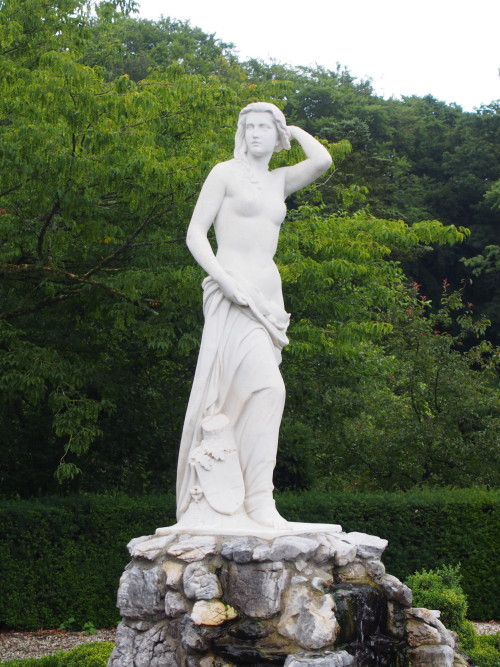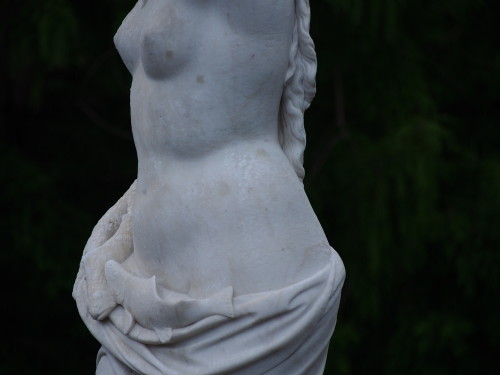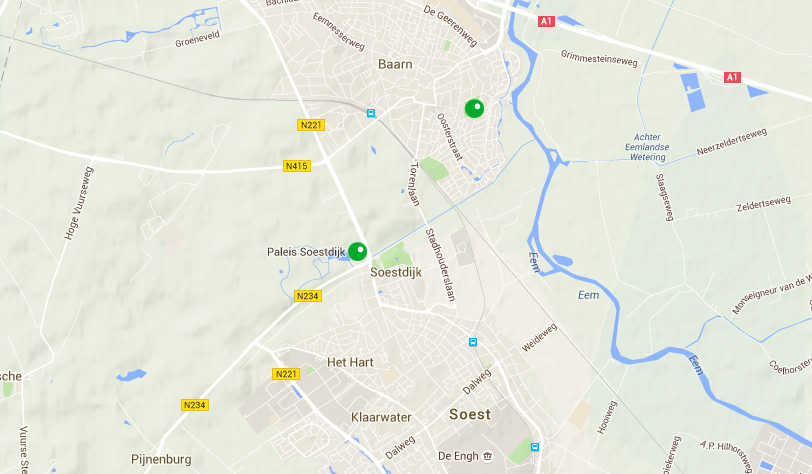Apart from being the name of an 1887 waltz by Johann Strauss, the name Donauweibchen probably does not ring too many bells. The name refers to a legendary nymph, who brought good luck to the fishermen of the Danube river near Vienna.
It is no surprise then, that Vienna boasts several statues of this nymph. One statue, created by Hanns Gasser (1817-1868), was unveiled in 1865 as the first statue in the Wiener Stadtpark -although it was originally created in 1858 and intended for a different location in the city. 1In the mean time, a bronze fountain with a Donauweibchen as the top figure -holding a fish in her right hand- designed by Heinrich von Ferstel had been erected in a bank building in 1861. The fountain is still there in what is now called Palais Ferstel.
Up till 1860, Gasser was Vienna’s most celebrated sculptor. The last years of his life a neglected injury to his right hand increasingly impaired his ability to sculpt -his studio had to take over. (W. Krause, ‘Han(n)s Gasser’, in Saur, Allgemeines Künstler Lexikon, Band 50 (June 2006), p.52). In 1948 the war-damaged original was replaced by a copy. A few other copies of this statue, as well as other versions, are situated elsewhere in Vienna.
 Where one would not necessarily expect to see an exact copy of Gasser’s statue, is in a garden in the Netherlands, surprisingly not even close to that other large European river, the Rhine.
Where one would not necessarily expect to see an exact copy of Gasser’s statue, is in a garden in the Netherlands, surprisingly not even close to that other large European river, the Rhine.
That might explain why Paleis Soestdijk, the garden in question, provides a wrong identification of the statue. In their guide book she is identified as a Venus, 2Katelijne Eissens / Kunsthistorisch Bureau D’Arts, Paleis Soestdijk. Wandeling door het Park (Rijksgebouwendienst Den Haag, 2011), p.36-37. even though Wim Meulenkamp had already correctly identified the statue as a representation of the Donauweibchen in 2008 -in a publication commissioned by the same organisation. 3Wim Meulenkamp, Cementrustieke brug tegenover het Prinses Wilhelmina châlet in het park van Paleis Soestdijk: maker, techniek, herstel en waardebepaling; met opmerkingen over de kunstrotsen in de nabijheid van de brug en de basis van het Donauweibchen vóór de kassen of bloemserres, (Rijksgebouwendienst Den Haag, 2008).
 I must confess that I didn’t see it immediately either, and wouldn’t have come up with the name myself. As obvious as it was that the Yorke House Venus just couldn’t be one of the nymphs, as unclear to me the iconography was here.
I must confess that I didn’t see it immediately either, and wouldn’t have come up with the name myself. As obvious as it was that the Yorke House Venus just couldn’t be one of the nymphs, as unclear to me the iconography was here.
But as soon as one notices the two fishes sculpted in her lap, just above the line of her garment, any identification with Venus is out the window.
The description in the national register of monuments cleverly remains neutral about the identification, but most probably reads the monogram on one of the shields at the foot of the statue wrong (HC, where HG would make more sense):
Op een rotsachtig basement is een marmeren beeld, een mythologisch of allegorisch vrouwenfiguur, geplaatst. Aan haar voet staat een boomstam met twee gekoppelde heraldische wapens en een klein wapenschildje met het monogram HC en het jaartal 1858. 4The ‘image library’ (beeldbank) -operated by the same national cultural heritage agency (RCE)- consistently calls her Venus, though.
Based on the date on the statue, the register of monuments claims the area it sits in was designed and laid out around 1858. But we already saw that even the original statue of Hanns Gasser was not unveiled in Vienna until seven years later. In that same year, 1865, prince Willem Frederik Hendrik (1820-1879) inherited Soestdijk, his place of birth. Prince Hendrik had been appointed governor (stadhouder) of the Duchy of Luxembourgh in 1850, where he resided at Castle Walferdange. Soestdijk was meant to be his summer residence.
Perhaps the statue, newly unveiled in its hometown Vienna, was a celebratory gift for prince Hendrik, to adorn his new garden at Paleis Soestdijk?
Location of Paleis Soestdijk, to the north east of Utrecht.
Footnotes
| ↑1 | In the mean time, a bronze fountain with a Donauweibchen as the top figure -holding a fish in her right hand- designed by Heinrich von Ferstel had been erected in a bank building in 1861. The fountain is still there in what is now called Palais Ferstel. Up till 1860, Gasser was Vienna’s most celebrated sculptor. The last years of his life a neglected injury to his right hand increasingly impaired his ability to sculpt -his studio had to take over. (W. Krause, ‘Han(n)s Gasser’, in Saur, Allgemeines Künstler Lexikon, Band 50 (June 2006), p.52). |
|---|---|
| ↑2 | Katelijne Eissens / Kunsthistorisch Bureau D’Arts, Paleis Soestdijk. Wandeling door het Park (Rijksgebouwendienst Den Haag, 2011), p.36-37. |
| ↑3 | Wim Meulenkamp, Cementrustieke brug tegenover het Prinses Wilhelmina châlet in het park van Paleis Soestdijk: maker, techniek, herstel en waardebepaling; met opmerkingen over de kunstrotsen in de nabijheid van de brug en de basis van het Donauweibchen vóór de kassen of bloemserres, (Rijksgebouwendienst Den Haag, 2008). |
| ↑4 | The ‘image library’ (beeldbank) -operated by the same national cultural heritage agency (RCE)- consistently calls her Venus, though. |




I can’t help but link to this image of Hagen and the Nymphs of the Danube.
Made by Swiss artist Henry Fuseli, in 1802.